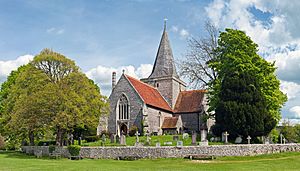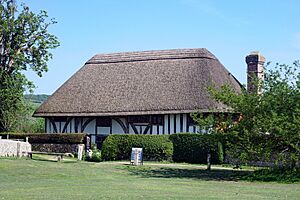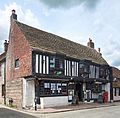Alfriston facts for kids
Quick facts for kids Alfriston |
|
|---|---|
| Village | |
 Alfriston village sign |
|
| Area | 9.36 km2 (3.61 sq mi) |
| Population | 829 (2011) |
| • Density | 214.2/sq mi (82.7/km2) |
| OS grid reference | TQ519030 |
| • London | 49 miles (79 km) NNW |
| Civil parish |
|
| District |
|
| Shire county | |
| Region | |
| Country | England |
| Sovereign state | United Kingdom |
| Post town | POLEGATE |
| Postcode district | BN26 |
| Dialling code | 01323 |
| Police | Sussex |
| Fire | East Sussex |
| Ambulance | South East Coast |
| EU Parliament | South East England |
| UK Parliament |
|
Alfriston is a charming village and civil parish in East Sussex, England. It's located in the valley of the River Cuckmere, about 6 kilometers (4 miles) northeast of Seaford. In 2011, about 829 people lived in the village.
Contents
History of Alfriston
There's strong proof that people lived in the Alfriston area a very long time ago. Several ancient burial mounds, called barrows, from the Neolithic period (New Stone Age) have been found on the nearby South Downs. One of these, called Long Burgh, is still quite well preserved.
The name 'Alfriston' first appeared in the Domesday Book in 1086. This was a huge survey of England ordered by William the Conqueror. The name means 'Ælfric's town or settlement'.
One important old building is the Star Inn. It was built in 1345 as a place for monks and pilgrims to stay. They were traveling from Battle Abbey to a special religious place in Chichester Cathedral. In the 16th century, it became an inn. You can see wooden figures on the top part of the building. At the front, there's a large wooden figure of a red lion, which used to be on the front of a ship. This lion is linked to the Alfriston smuggling gang, who used the inn as their base. Their leader was sent to Australia in 1830. Another old building is Dean's Place Hotel, which was built in the 1600s or even earlier.
How Alfriston is Governed
Alfriston is part of an electoral ward (a local voting area) that has the same name. This ward stretches north to Chalvington with Ripe. In 2011, the total population of this ward was 2,321 people.
Churches in Alfriston
The main church in Alfriston is St Andrew's Church. It has parts that date back to Saxon times, but most of the building was built in the 14th century. Because of its large size, it's often called the "Cathedral of the South Downs."
The church sits on a small, flint-walled hill in the middle of "the Tye," which is the village green. It looks out over the River Cuckmere. Famous people like Nobel Prize winner Sir Peter Medawar and politician Denis Healey are buried in its graveyard. The church is built in the shape of a cross.
The Village of Alfriston
The eastern side of Alfriston is next to the River Cuckmere. Here you'll find the village green, known as the Tye. St Andrew's Church is right in the middle of the Tye.
Close by is the 14th-century Alfriston Clergy House. It was first a farmhouse, then a vicarage (where the local priest lived). Now, the National Trust looks after it. It was actually the very first property the National Trust bought, back in 1896! It's a great example of a Wealden hall house with a thatched roof and timber-framed walls. It also has a peaceful garden and orchard by the Cuckmere River.
Also on the Tye is the Georgian Unitarian Chapel. The wooden sign for the village, at the entrance to the Tye, was carved by a former vicar of the village.
In the center of the village is Market Square. Here you can see a 15th-century market cross.
The village has four pubs: the Star Inn, the Smugglers' Inn, the George Inn, and the Six Bells. An archaeology TV show, Pub Dig, found signs of smuggling and other old activities at the Smugglers' Inn.
The South Downs Way, a famous walking path, crosses the river in Alfriston. It then continues up onto the Downs.
Every August, there's the Alfriston Festival. It ends with a big fair on the Tye, which raises money for local charities. Many people from all around come to this event. In December, there's also an Alfriston Christmas Weekend. The village even has its own clay pigeon shooting club. The Alfriston Cricket Club has won the Cuckmere Valley League nine times!
Alfriston in the Arts
In 1931, Eleanor Farjeon wrote the famous hymn "Morning Has Broken" in Alfriston. People say the hymn is about the beautiful nature she saw in the village. Later, in the 1970s, the song was recorded by Cat Stevens, making it even more popular.
The 1946 novel Uneasy Terms by crime writer Peter Cheyney is mostly set in and around Alfriston. The main character, a detective named Slim Callaghan, stays in one of the pubs in Alfriston (called 'The Two Friars' in the book). He solves a murder at a nearby house. The author describes the village as a pleasant place with old houses and nice shadows from the trees. Other nearby places are also mentioned in the book. The novel was even made into a film in 1948.
Another well-known thriller writer, Victor Canning, starts his 1956 novel The Hidden Face in Alfriston.
The 1964 film The Chalk Garden, starring Sir John Mills, Hayley Mills, and Deborah Kerr, was filmed in and around the village.
Peter Sellers' 1962 film Waltz of the Toreadors was also filmed here.
Notable People from Alfriston
- Dr June Goodfield (born 1927) – a historian, scientist, and writer.
- Denis Healey, Baron Healey (1917–2015) – a British politician who served as Secretary of State for Defence and Chancellor of the Exchequer.
- Edna Healey (1918–2010) – an author, lecturer, and filmmaker, and wife of Denis Healey.
- Albert Hilton (1862–1935) – an English cricketer who played for Sussex.
- Peter Medawar (1915–1987) – a Nobel Prize winner, buried in Alfriston with his wife.
- Elgar Pagden (1820–1880) – a first-class cricketer.
- Jacqueline Wilson (born 1945) – a famous children's author, known for the Tracy Beaker books, who lives in Alfriston.
Images for kids
See also
 In Spanish: Alfriston para niños
In Spanish: Alfriston para niños









